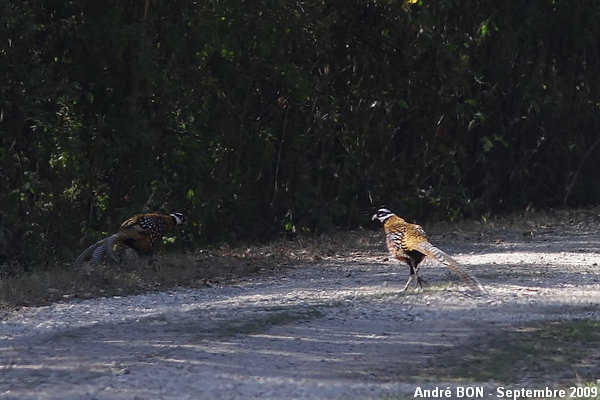
| Reeves's Pheasant (Syrmaticus reevesii (Gray, 1831)) |

|
|
Scientific name: Syrmaticus reevesii (Gray, 1831) Common name: Reeves's Pheasant Other names: White-necked Long-tailed Pheasant French name: Faisan vénéré, Faisan de Reeves Order: Galliformes Family: Phasianidae Size: The Reeves's Pheasant is one of the species showing the longest tail. It can reach 2 meters long on males. Body size: 80cm for males, 50cm for females. Habitat: Mixed forests and woodlands at medium altitude. The Reeves's Pheasant also visit the cultivated areas in the neighbourhood to feed. Food: Omnivorous. However the Reeves's Pheasant mainly feeds on seeds and fruits picked up on the ground. It is considered as a pest for some crops. It sometimes feeds son insects and other invertebrate species. Nesting: The nest is a heap of grasses and leaves located on the ground, hidden under a bush. Males are generally monogamous during the breeding season. Females lay 6 to 10 eggs, between March and July, and sit on the eggs alone. Migration: Sedentary. Geographic area: Originated from the mountain of central and north-west China, the Reeves's Pheasant was introduced to Europe since 1831 by John Reeves (this explains the scientific and English common names of this species). It is now found in Germany, Austria, Scotland, France and Czech republic. |
You can recognize the Reeves's Pheasant by its white head, crossed by a black stripe starting from the forehead, running on the eyes and extending to the nape. The head and the body are separated by a thin black collar. The rest of the plumage is golden brown with black patterns. The tail is long and barred with black. Females are a duller colour with a brown and buff plumage. The head and the chest are a uniform buff colour. The top of the head is dark brown and there is a dark band behind the eyes. |
| [To know more about the Reeves's Pheasant] [Top] |

|
I have observed these Reeves's Pheasants in the forest of Rambouillet. These birds were introduced to this place for hunting and I have shot these pictures before the beginning of the massacre. Hurrah for hunting … but hunting for pictures only! |